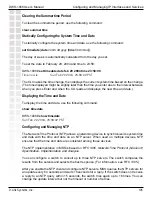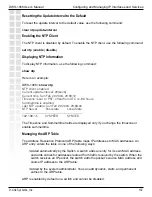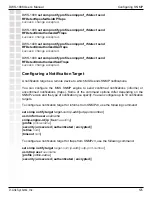
110
DWS-1008 User’s Manual
D-Link Systems, Inc.
Configuring and Managing IP Interfaces and Services
To establish a Telnet session from the switch to 10.10.10.90, type the following command:
DWS-1008#
telnet 10.10.10.90
Session 0 pty tty2.d Trying 10.10.10.90...
Connected to 10.10.10.90
Disconnect character is ‘^t’
Copyright (c) 2002, 2003
D-Link Systems, Inc.
Username:
When you press Ctrl+t or type
exit
to end the client session, the management session returns
to the local prompt:
DWS-1008-remote> Session 0 pty tty2.d terminated tt name tty2.d
DWS-1008#
Use the following commands to manage Telnet client sessions:
show
sessions
telnet client
clear
sessions
telnet
client
[
session-id
]
These commands display and clear Telnet sessions from an Switch’s Telnet client to another
device.
To display the Telnet client sessions on an Switch, type the following command:
DWS-1008#
show sessions telnet client
Session
Server Address
Server Port
Client Port
---------------------------------------------------------------------------------------
0
192.168.1.81
23
48000
1
10.10.1.22
23
48001
To clear Telnet client session 0, type the following command:
DWS-1008#
clear sessions telnet client 0
You also can clear a Telnet client session by typing
exit
from within the client session.
Tracing a Route
You can trace the router hops necessary to reach an IP host.
The traceroute facility uses the TTL (Time to Live) field in the IP header to cause routers and
servers to generate specific return messages. Traceroute starts by sending a UDP datagram
to the destination host with the TTL field set to 1. If a router finds a TTL value of 1 or 0, it drops
the datagram and sends back an ICMP
Time Exceeded
message to the sender.






























